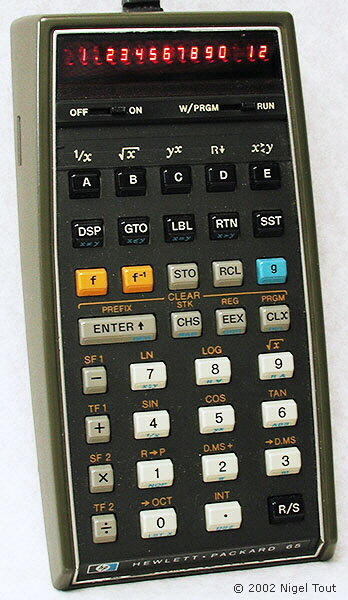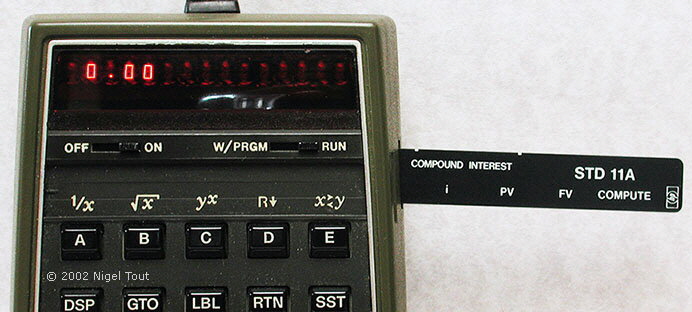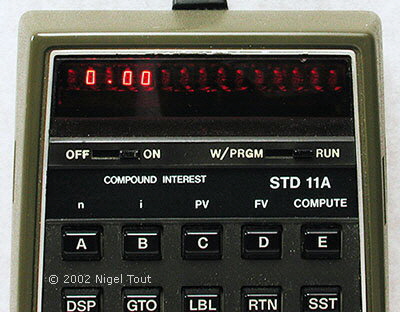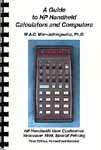Hewlett-Packard HP-65

Hewlett-Packard HP-65
Distinctive features: The first hand-held, programmable calculator.
Technical details:
Display uses scientific notation, 10 digits mantissa, 2 digits exponent, red LED.
Scientific, programmable, with 100 program steps.
3.6v (3x AA rechargeable cells in a battery pack).
80 x 149 x 36 mm (3.2" x 5.9" x 1.4").
Launched in January 1974.
Made in USA.
Price US$795.
This was the first hand-held programmable calculator. Programs can be stored on magnetic cards, see photographs below, though these had been used previously with desktop programmable calculators. Program libraries for performing calculations for various disciplines could be purchased from HP.


Above, "Compound Interest" program about to be read from the magnetic card. The card is driven through the calculator by a tiny motor inside, from right to left.
Left, after the program has been read in, the card is inserted in a slot below the display and there provides the legends for the keys A to E.
An article in the journal 'Electronic Design' explained some of the problems involved in developing this calulcator[1]:
"How HP engineers built the world's first pocket programmable calculator
...
According to Chung C. Tung, engineering group manager for the HP-65, a primary requirement was that the calculator fit in the same case as its predecessors. This was no easy
task. The computing power had to be enhanced by an increase in the number of chips from five to 12, and a magnetic card-reading mechanism had to be included.
Three new chips were developed for this calculator:
a bipolar sense amp chip for the card reader, a PMOS program storage chip that would interface with the other PMOS chips already developed for the earlier calculators and an NMOS card reader logic chip. NMOS was chosen, Tung
says, because HP has NMOS capability and it wanted to do the job in-house.
Tung notes that the designers realized fairly early that it would be impossible to fit 12 discrete integrated circuits into a space
originally designed to hold only five. So they decided to use hybrid circuit construction.
Six of the IC chips were bonded to a ceramic substrate and interconnected to form one large hybrid IC. This
reduced significantly the space needed for the electronics.
The next major problems, reports Tung, was the magnetic card reader. "At first we thought we might use a motor and gear arrangement, similar to that
found in watches," he explains. But that proved to be too big and complicated; there were too many mechanical parts that could go bad. The reading-mechanism problem was solved by the use of a small brush-less motor and
a simple worm gear. The gear drives a roller that moves the card through at a steady rate.
...
In addition to doing his own programming, the user can expand the capability of the machine with a
series of prerecorded programs available from HP. Initially a total of six such Application Pacs are available for electrical engineering, mathematical, statistical, medical and surveying applications. Each costs
$45, contains between 27 and 40 programs and comes with a comprehensive instruction manual. Additional sets of prerecorded programs will be offered as they are developed.
..."
The journal 'Electronic Design' gave some more details[2]:
"HP-65 calculator arrives: First pocket programmable
...
The NMOS IC contains the control circuitry for the card reader, while the four bipolar chips contain the motor control, clock and display driver and sense-amp circuitry. The seven PMOS
chips consist of three quad ROMs, a processor, a controlled timing chip, a data-storage chip and a program-storage chip. Hybrid circuit construction was used to allow all of them to fit into the small space available.
...
The HP-65 is described in considerable detail in the Hewlett-Packard Journal of May 1974.
There is an enormous amount of information about the HP-65 gathered by David Hicks at the Museum of HP Calculators at https://www.hpmuseum.org/hp65.htm.
See also the Hewlett Packard HP-35, the first hand-held scientific calculator, and the Hewlett Packard HP-80, the first hand-held business and financial calculator.
Reference:
A Guide to HP Handheld Calculators and Computers
Revised Guide to HP Calculators Available
The fifth edition of Wlodek Mier-Jedrzejowicz's "A Guide to HP Handheld Calculators and Computers" has been published.
Hand-held Calculators
Vintage Calculators
Text & photographs copyright, except where stated otherwise, © Nigel Tout 2000-2026.
